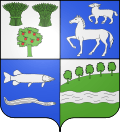Cany-Barville
| Cany-Barville | |
|---|---|
 Cany-Barville | |
|
Location within Upper Normandy region  Cany-Barville | |
| Coordinates: 49°47′19″N 0°38′22″E / 49.7886°N 0.6394°ECoordinates: 49°47′19″N 0°38′22″E / 49.7886°N 0.6394°E | |
| Country | France |
| Region | Upper Normandy |
| Department | Seine-Maritime |
| Arrondissement | Dieppe |
| Canton | Cany-Barville |
| Intercommunality | Côte d'Albâtre |
| Government | |
| • Mayor (2008–) | Jean Pierre Thévenot |
| Area | |
| • Land1 | 13.57 km2 (5.24 sq mi) |
| Population (2006) | |
| • Population2 | 3,226 |
| • Population2 Density | 240/km2 (620/sq mi) |
| INSEE/Postal code | 76159 / 76450 |
| Elevation |
10–126 m (33–413 ft) (avg. 25 m or 82 ft) |
|
1 French Land Register data, which excludes lakes, ponds, glaciers > 1 km² (0.386 sq mi or 247 acres) and river estuaries. 2 Population without double counting: residents of multiple communes (e.g., students and military personnel) only counted once. | |
Cany-Barville is a commune in the Seine-Maritime department in the Haute-Normandie region in northern France.
Geography
A farming and light industrial town situated by the banks of the river Durdent in the Pays de Caux, some 25 miles (40 km) southwest of Dieppe, at the junction of the D925, D10 and the D268 roads.
Heraldry
 |
The arms of Cany-Barville are blazoned : |
Population
| Year | 1962 | 1968 | 1975 | 1982 | 1990 | 1999 | 2006 |
|---|---|---|---|---|---|---|---|
| Population | 1629 | 1704 | 2209 | 3202 | 3349 | 3364 | 3226 |
| From the year 1962 on: No double counting—residents of multiple communes (e.g. students and military personnel) are counted only once. | |||||||
Places of interest
- The church of St. Siméon, at Barville, dating from the sixteenth century.
- The church of St. Martin, at Cany, dating from the thirteenth century.
- The seventeenth-century chapel of St. Gilles and St. Leu
- The seventeenth-century chateau de Cany, built between 1640 and 1656 by François Mansart, with its chapel and a park.
- Remnants of a fortified manorhouse dating from the fourteenth century.
- A feudal motte at Barville.
- The fifteenth century watermill and museum.
Notable people
- Louis Bouilhet, French poet, was born here.
See also
References
External links
- Official website of Cany-Barville (French)
- The Chateau website (French)
- Cany-Barville on the Quid website (French)